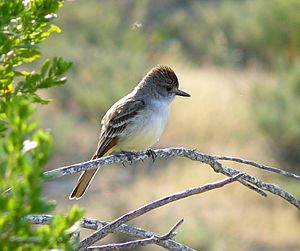Ash-throated flycatcher facts for kids
Quick facts for kids Ash-throated flycatcher |
|
|---|---|
 |
|
| In California, United States | |
| Conservation status | |
| Scientific classification | |
| Genus: |
Myiarchus
|
| Species: |
cinerascens
|
 |
|
| Synonyms | |
|
Tyrannula cinerascens |
|
The ash-throated flycatcher (Myiarchus cinerascens) is a type of passerine bird. It belongs to the tyrant flycatcher family. These birds live in different places like desert areas, forests near rivers, and open woodlands. You can find them from the western United States down to central Mexico.
Ash-throated flycatchers are short-distance migrants. This means they travel shorter distances for winter. They leave most of the U.S. and northern Mexico. They spend winter in southern Mexico all the way to Honduras. Sometimes, these birds wander far from their usual homes. They have even been seen on the east coast of North America.
These birds build their nests in tree holes. They also use other natural or man-made openings. A normal nest usually has three or four eggs.
Adult ash-throated flycatchers are about 7.5 to 8.5 in (19 to 22 cm) long. They weigh between 0.7 to 1.3 oz (20 to 37 g). Their upper body is olive brown. Their head is darker and has a small crest. The chest is gray, and the belly is very pale yellow. Their tail feathers and wings have rufous (reddish-brown) outer parts. They also have two dull bars on their wings. Male and female birds look very similar.
You can tell ash-throated flycatchers apart from similar birds by their calls. They make a rough prrt or wheer sound. They also make a burry kabrick sound. You can hear these calls all year round.
This bird mainly eats insects. It flies from a branch to catch prey. It finds food on the ground or in plants. Sometimes, it catches insects from tree trunks. Unlike many other flycatchers, it often flies to a new perch after catching food. It also eats some fruit, especially in winter. Rarely, it might eat small mammals or reptiles. It kills these by hitting them against hard objects.
Contents
Understanding the Ash-throated Flycatcher's Name
The ash-throated flycatcher was first described in 1851. This was done by George Newbold Lawrence. He found a specimen in western Texas. He first named it Tyrannula cinerascens. Later, in 1859, Philip Lutley Sclater moved it to its current group, Myiarchus.
The name Myiarchus comes from Greek words. Muia means "fly" and arkos means "ruler" or "chief". So, it means "fly ruler." The second part of its scientific name, cinerascens, is a Latin word. It means "ashen," which refers to its gray throat.
There are two types, or subspecies, of the ash-throated flycatcher:
- M. c. cinerascens: This type breeds in the western U.S. and central Mexico. It spends winter from the southern U.S. to Honduras.
- M. c. pertinax: This type lives only in Baja California, Mexico.
What Does the Ash-throated Flycatcher Look Like?
The ash-throated flycatcher is a medium-sized bird. It measures about 7.5 to 8.6 in (19 to 22 cm) long. Its wingspan is about 11.8 to 12.6 in (30 to 32 cm). It weighs between 0.7 to 1.3 oz (20 to 37 g).
This bird looks slim and has a long tail. Its head is quite large and has a slightly pointed crest.
Protecting the Ash-throated Flycatcher
The ash-throated flycatcher is doing well. It has a very large population. Its numbers are generally increasing. Because of this, it is listed as a species of Least Concern by the International Union for the Conservation of Nature. This means it is not currently at risk of disappearing.
This bird is also protected by the Migratory Bird Treaty Act. This law helps protect many bird species in North America. In the United States, people set up nest boxes for bluebirds. These are called bluebird trails. Ash-throated flycatchers can also use these boxes, which helps them find safe places to nest.
See also
 In Spanish: Copetón cenizo para niños
In Spanish: Copetón cenizo para niños



